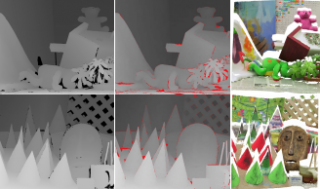Abstract
We present a fast and accurate method for dense depth reconstruction, which is specifically tailored to process sparse, wide-baseline light field data captured with camera arrays. In our method, the source images are over-segmented into non-overlapping compact superpixels. We model superpixel as planar patches in the image space and use them as basic primitives for depth estimation. Such superpixel-based representation yields desired reduction in both memory and computation requirements while preserving image geometry with respect to the object contours. The initial depth maps, obtained by plane-sweeping independently for each view, are jointly refined via iterative belief-propagation-like optimization in superpixel domain. During the optimization, smoothness between the neighboring superpixels and geometric consistency between the views are enforced. To ensure rapid information propagation into textureless and occluded regions, together with the immediate superpixel neighbors, candidates from larger neighborhoods are sampled. Additionally, in order to make full use of the parallel graphics hardware a synchronous message update schedule is employed allowing to process all the superpixels of all the images at once. This way, the distribution of the scene geometry becomes distinctive already after the first iterations, facilitating stability and fast convergence of the refinement procedure. We demonstrate that a few refinement iterations result in globally consistent dense depth maps even in the presence of wide textureless regions and occlusions. The experiments show that while the depth reconstruction takes about a second per full high-definition view, the accuracy of the obtained depth maps is comparable with the state-of-the-art results, which otherwise require much longer processing time.
